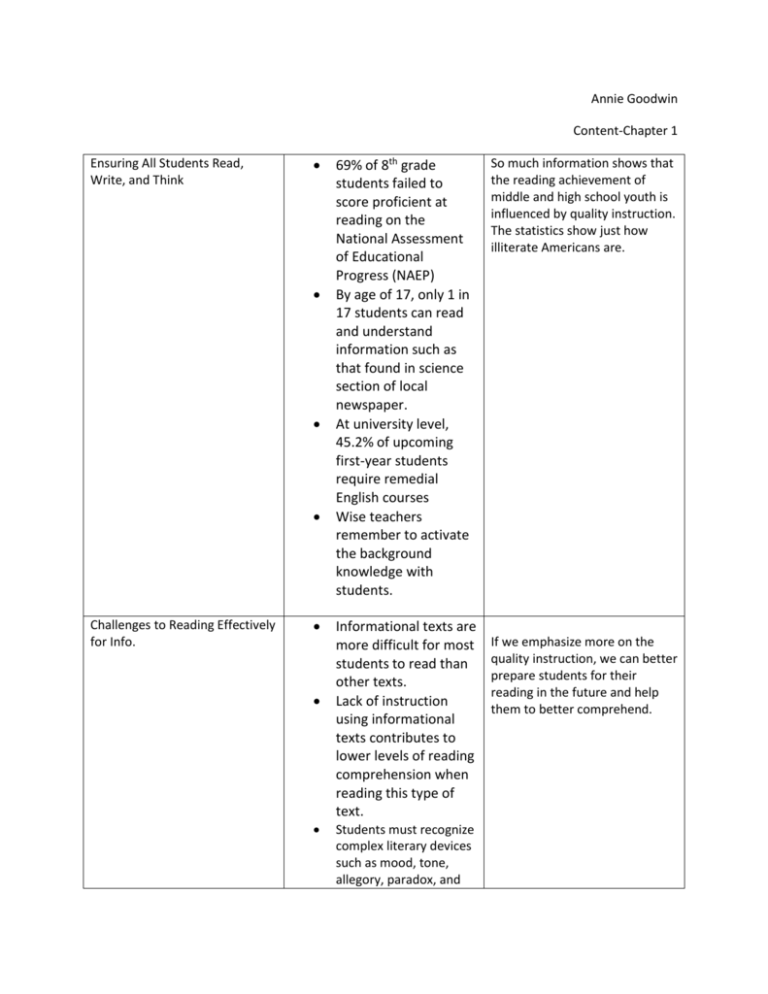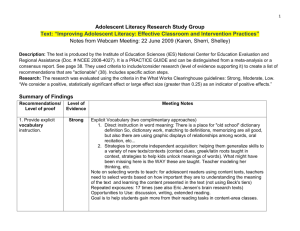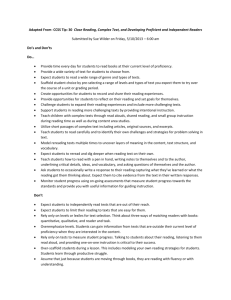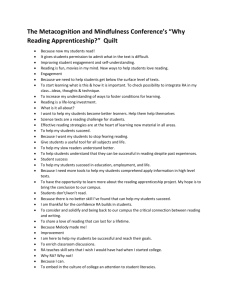Chapter 1 notes
advertisement

Annie Goodwin Content-Chapter 1 Ensuring All Students Read, Write, and Think Challenges to Reading Effectively for Info. 69% of 8th grade students failed to score proficient at reading on the National Assessment of Educational Progress (NAEP) By age of 17, only 1 in 17 students can read and understand information such as that found in science section of local newspaper. At university level, 45.2% of upcoming first-year students require remedial English courses Wise teachers remember to activate the background knowledge with students. Informational texts are more difficult for most students to read than other texts. Lack of instruction using informational texts contributes to lower levels of reading comprehension when reading this type of text. Students must recognize complex literary devices such as mood, tone, allegory, paradox, and So much information shows that the reading achievement of middle and high school youth is influenced by quality instruction. The statistics show just how illiterate Americans are. If we emphasize more on the quality instruction, we can better prepare students for their reading in the future and help them to better comprehend. symbolism. Common Types of Informational Texts What are the Characteristics of Informational Texts? Trade books are books Teachers need to be open to all kinds of texts that are produced for the public market. Photo-essays are a unified collection of photographs that explore some aspect of the human experience. As technology continues to increase, we as teachers need to consider how students will use a variety of texts in the classroom. Informational texts differ from narrative texts in tone, style, structure, features, and authority. “Authority” is one of the most distinguishing attributes between information and narrative texts. Exemplification text describes people, places, or phenomena. Compare/ contrast text structures also rely on descriptive text, but instead explain how two or more people, places, or phenomena are similar or different. Cause/ effect text structures, which show the casual relationships between It’s important for students to use informational texts because it will help them grasp what’s going on. Common Expository Text Structures Text Features Common Text Styles phenomena, can be deceptively similar to compare/ contrast, but their signal words give them away. Problem/ solution text is that it’s subtler than some of the others and may develop over the course of several sentences or paragraphs. ”Exemplification” text describes people, places, or phenomena. Signal words for exemplification texts include adjectives, adverbs, and phrases. “Temporal” structures use chronology or a sequence of events to inform the reader. Each is beneficial to the student in comprehending the material. Text features are structural items that are used to organize content. Examples of text features are headings, bulleted items, index, etc. Text structures expand reader comprehension of content. Text features help organize the information in the textbooks which helps the students understand more clearly. It is important for students to know how to use text features. Teachers can help students understand fiction by providing ideas as to how different types of genres are structured. Cause and effect is the Students need to know how to analyze information on their own and grasp the concepts. Critical Literacy and Its Relation to Reading for Information Supporting Reading for Information Developing Reading Comprehension most common type of text structure used in a text such as a science book. “Critical literacy” is the ability to move beyond simple extraction of information. “Disrupting the commonplace” is an aspect that invites students to look at their everyday world in a different way. “Teaching is not a neutral form of social practice.” Teachers should help students develop an understanding of their world, question it, and take action. We need to teach students how to read for information so that they can ask questions to better understand things. Content area teachers We as teachers need to understand the text in order to who are offer more support. knowledgeable about how text is understood are able to offer better support and instruction in using content area texts. It is important not to teach reading comprehension strategies in isolation from one another. “Metacognition” is the awareness of how one learns. Comprehension occurs Students need a plan so that they can understand what they with the use of read. The Benefits for English Language Learners Conclusion activities that are designed to teach students what good readers do. Readers use metacognitive skills in reading when they develop a plan of action, maintain/monitor the plan, and evaluate the plan. Teaching students what to do before, during, and after they read is essential for reading comprehension. Integrating language and content is important for effective teaching for English learners. English learners need instruction in text structures, text features, and comprehension strategies. English learners also need instruction in fluency, vocabulary, and grammar. Students must learn to read for information, no matter how old they are. Guiding readers through texts in order to understand content is an essential responsibility of every They too need instruction like beginning readers and have the ability to be successful. I feel like I need to drive my students to be successful readers and teach them how to read so they may be successful learners. teacher. Summary: Overall, students need to learn how to organize and comprehend what they read so that they can grasp the information and understand it. When the information is grasped, students can become successful readers.







